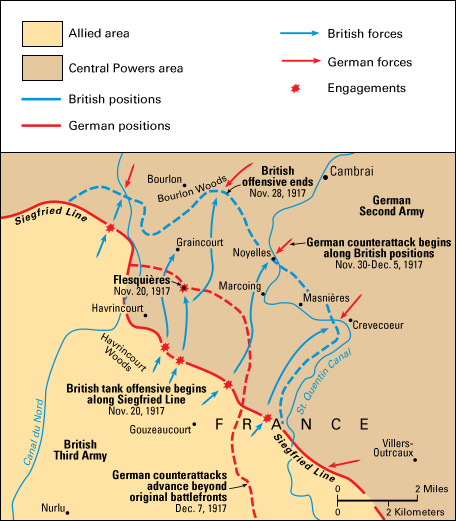Cambrai, Battle of, was fought between British and German forces during World War I (1914-1918). The battle took place near the northern French city of Cambrai from Nov. 20 to Dec. 7, 1917. The battle is famous for the mass use of tanks . The British gained ground early in the battle, but the Germans recovered. The battle eventually ended in a draw.
Background.
The Germans took Cambrai in late August 1914. The city then became an important administrative, communications, and supply center for German forces. Portions of the Western Front—the battlefront stretching from Belgium across northeastern France—were less than 10 miles (16 kilometers) south and west of Cambrai. The Germans fortified the area with a deep system of defenses. The area was part of a defense network called the Siegfriedstellung, or Siegfried Line . The Allies called the network the Hindenburg Line, after German General Paul von Hindenburg .

At that stage in the war, the area southwest of Cambrai was one of the few places on the Western Front where battle had not yet churned the ground to mud. The unspoiled land—mainly rolling hills and solid farmland—was thus well suited for tank warfare. British tanks, first used in 1916, previously had appeared in small numbers and made little impact. But for the assault on Cambrai, the British gathered more than 370 combat tanks. Another 100 tanks served in support.
The British tanks would lead a combined force that included infantry and more than 1,000 heavy guns. Five cavalry divisions waited for a break in the German line. British forces included some American engineers and a number of Commonwealth troops. Nearly 300 British warplanes provided close air support.
German troops held the defenses southwest of Cambrai. The area was considered secure, and an attack was not expected.
The battle.
Early on Nov. 20, 1917, British heavy guns began firing on the German lines. British tanks led the infantry into no man’s land (the area between the opposing lines) along a 6-mile (10-kilometer) front. The tanks crushed the German defenses and rolled over trenches. British troops then took possession of the shattered German lines. Thousands of German troops fled or surrendered.
Concentrated German artillery fire stopped some tanks, notably near the village of Flesquières. But the British advanced as much as 5 miles (8 kilometers) along the front—a major success compared to earlier battles where little or no ground was gained.
The Battle of Cambrai seemed to be a decisive British victory. In the United Kingdom, church bells—largely silent since the war began—rang in celebration. However, British cavalry failed to follow through on the breakthrough. The British were soon stopped by bad weather, communication and supply problems, and increasing German fire.
German troops—reinforced and recovered from the surprise attack—counterattacked on November 30. Over the next several days, British forces retreated, with many soldiers captured, wounded, or killed. The British managed to hold a portion of the Siegfried Line in the northern part of the battle area. However, the Germans retook most of the lost ground, advancing beyond the original front line in the south. The battle ended on December 7, though some fighting in the area continued for the rest of the month.
Aftermath.
The British and Germans each suffered about 45,000 casualties (people killed, wounded, missing, and captured) in the Battle of Cambrai. Nearly two-thirds of the British tanks were destroyed, became stuck, or broke down. The initial success, however, showed that the new tank tactics could work. Cambrai-style attacks were repeated with greater, lasting success in later campaigns.
In October 1918, British and Commonwealth troops fought the Germans in a second battle at Cambrai. Again, tanks and infantry made quick, significant gains. At this point in the war, however, German troops were unable to counterattack, and Cambrai was liberated. World War I ended on November 11.
